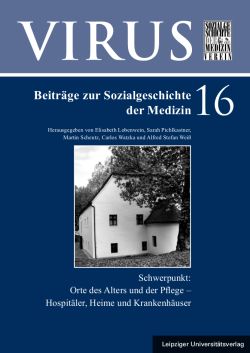 |
 |
VIRUS
Beiträge zur Sozialgeschichte der Medizin
Band 16
Schwerpunkt: Orte des Alters und der Pflege – Hospitäler, Heime und Krankenhäuser
 Carlos Watzka Carlos Watzka
S. 065 - 098 doi: 10.1553/virus16s065 doi: 10.1553/virus16s065
Abstract:
This article deals with nursing within the Austrian hospitals of the Order of St. John of God during the 17th and 18th centuries. As far as possible, it casts light on the actual nursing practices, primarily displaying and analysing contemporary internal nursing guidelines and sources like inventories, pictures and administrative patients’ records. Thus, the paper attempts to “reconstruct” at least the expected and/or typical shape of some fundamental aspects of nursing care based on such indirect hints, being well aware, however, that this can only serve as a modest substitute for an – impossible − actual observation. Furthermore, scrutinizing guidelines, administrative records and similar material can easily lead to misinterpretations regarding the relation of norms and actual behavior; therefore, we must also bear in mind that variations and deviations are probably under-represented within such sources. This considered, some elementary insights drawn from the mentioned sources, are: The early modern hospitals of the “Barmherzige Brüder” – which already served as medical hospitals for acute diseases – disposed of remarkably well-equipped pharmacies and a well-educated staff. The brethren themselves conducted most of the nursing duties. A “Manuale” for their use from 1681 elaborately describes aims, but also problems in nurse-patient communication, moreover the necessary observation of vital functions in very “weak” patients, and several aspects of hygiene of the body, the beds, the laundry and the wards, as well as the nutrition of the patients – who were i. e. supposed to drink either boiled water or wine according to the individual diet prescribed by the physician and had two main meals a day, breakfast and dinner. The handling of the excretions was a matter discussed in less detail, but it was not avoided in total. Clothing is mentioned primarily with respect to the change of wear that was scheduled to take place during admission and regarding the correct storage of the ‘secular’ costumes until discharge. Rest and sleep was a matter of interest, too. The brethren were obviously well aware of the potentially conflicting target of securing the prior on the one hand, and effective nursing care, particularly in urgent cases, on the other. Moreover, the themes of movement and occupation possibilities for the patients are displayed. The aspect of sexuality is dealt with in the “Manuale” primarily with reference to specific demands of the staff’s clerical celibacy, only casually referring to the sick themselves. ‘Security’ is only marginally dealt with by the nursing guidelines, but, apart from hygienic prescriptions, does not play a prominent role. Yet, by other sources it becomes sufficiently clear, that there were specific security measures for distinct categories of patients, such as “mad” patients regarded dangerous for themselves or others. On the contrary, the “Manuale” pays ample attention towards the spiritual offers to and demands of the patients, which were closely linked to the strict daily routine of the brethren, largely filled by manifold and extent religious rituals.
Nursing history, nursing practices, hospitals, Early Modern Times, Order of St. John of God, history of health and illness in Austria Published Online:
2020/07/22 20:49:14 Object Identifier:
0xc1aa5576 0x003bb5c3
Rights:https://creativecommons.org/licenses/by/4.0/
Die Zeitschrift "Virus - Beiträge zur Sozialgeschichte der Medizin" ist das Publikationsorgan des Vereins für Sozialgeschichte der Medizin und erscheint einmal jährlich.
Sie versammelt wissenschaftliche Beiträge verschiedener Disziplinen, die sich mit Themen aus den Bereichen Medizin, Gesundheit und Krankheit in historischer, kultur- und/oder sozialwissenschaftlicher Perspektive empirisch auseinandersetzen. Weitergehende Einschränkungen für Beitragsvorschläge in thematischer oder methodischer Hinsicht bestehen nicht.
Der "Virus" publiziert vornehmlich Beiträge mit Bezug zur Geschichte der Medizin in Österreich, dessen Nachbarländern sowie der ehemaligen Habsburgermonarchie. Vergleichend angelegte Arbeiten können aber über diesen Rahmen auch hinausgreifen. Hinsichtlich der behandelten Zeiträume bestehen keine Eingrenzungen, jedoch stehen Beiträge zur Medizin in der Neuzeit und der Moderne/Postmoderne im Vordergrund (16.-21. Jahrhundert).
…
|




 Home
Home Print
Print
 References
References
 Share
Share
 Carlos Watzka
Carlos Watzka